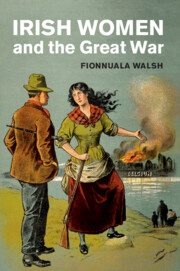Refine search
Actions for selected content:
15418 results in Military history
Conclusion
-
- Book:
- Irish Women and the Great War
- Published online:
- 15 July 2020
- Print publication:
- 16 July 2020, pp 223-230
-
- Chapter
- Export citation
Tables
-
- Book:
- Irish Women and the Great War
- Published online:
- 15 July 2020
- Print publication:
- 16 July 2020, pp vi-vi
-
- Chapter
- Export citation
5 - Politicisation
-
- Book:
- Irish Women and the Great War
- Published online:
- 15 July 2020
- Print publication:
- 16 July 2020, pp 164-193
-
- Chapter
- Export citation
6 - Demobilisation
-
- Book:
- Irish Women and the Great War
- Published online:
- 15 July 2020
- Print publication:
- 16 July 2020, pp 194-222
-
- Chapter
- Export citation
Index
-
- Book:
- Irish Women and the Great War
- Published online:
- 15 July 2020
- Print publication:
- 16 July 2020, pp 251-254
-
- Chapter
- Export citation
Select Bibliography
-
- Book:
- Irish Women and the Great War
- Published online:
- 15 July 2020
- Print publication:
- 16 July 2020, pp 231-250
-
- Chapter
- Export citation
Contents
-
- Book:
- Irish Women and the Great War
- Published online:
- 15 July 2020
- Print publication:
- 16 July 2020, pp v-v
-
- Chapter
- Export citation
1 - Mobilising for the War Effort
-
- Book:
- Irish Women and the Great War
- Published online:
- 15 July 2020
- Print publication:
- 16 July 2020, pp 21-63
-
- Chapter
-
- You have access
- HTML
- Export citation
Abbreviations
-
- Book:
- Irish Women and the Great War
- Published online:
- 15 July 2020
- Print publication:
- 16 July 2020, pp x-xii
-
- Chapter
- Export citation
Introduction
-
- Book:
- Irish Women and the Great War
- Published online:
- 15 July 2020
- Print publication:
- 16 July 2020, pp 1-20
-
- Chapter
- Export citation
4 - Working Lives
-
- Book:
- Irish Women and the Great War
- Published online:
- 15 July 2020
- Print publication:
- 16 July 2020, pp 125-163
-
- Chapter
- Export citation

Irish Women and the Great War
-
- Published online:
- 15 July 2020
- Print publication:
- 16 July 2020

The Hunger Winter
- Fighting Famine in the Occupied Netherlands, 1944–1945
-
- Published online:
- 04 July 2020
- Print publication:
- 23 July 2020
Appendices
-
- Book:
- Why Allies Rebel
- Published online:
- 05 June 2020
- Print publication:
- 02 July 2020, pp 274-288
-
- Chapter
- Export citation
3 - Methodology
-
- Book:
- Why Allies Rebel
- Published online:
- 05 June 2020
- Print publication:
- 02 July 2020, pp 55-79
-
- Chapter
- Export citation
6 - The USA in Vietnam
-
- Book:
- Why Allies Rebel
- Published online:
- 05 June 2020
- Print publication:
- 02 July 2020, pp 155-187
-
- Chapter
- Export citation
Appendix C - Statistical Tables
-
- Book:
- Why Allies Rebel
- Published online:
- 05 June 2020
- Print publication:
- 02 July 2020, pp 284-288
-
- Chapter
- Export citation
5 - The USA in Afghanistan
-
- Book:
- Why Allies Rebel
- Published online:
- 05 June 2020
- Print publication:
- 02 July 2020, pp 120-154
-
- Chapter
- Export citation
9 - When Small States Intervene
-
- Book:
- Why Allies Rebel
- Published online:
- 05 June 2020
- Print publication:
- 02 July 2020, pp 236-257
-
- Chapter
- Export citation
4 - The USA in Iraq
-
- Book:
- Why Allies Rebel
- Published online:
- 05 June 2020
- Print publication:
- 02 July 2020, pp 80-119
-
- Chapter
- Export citation
